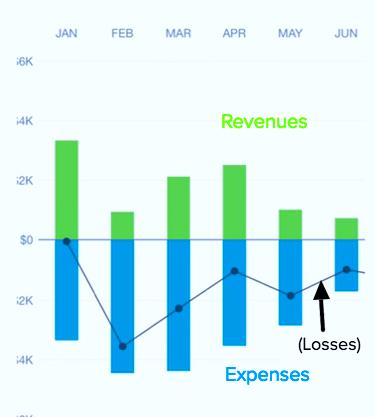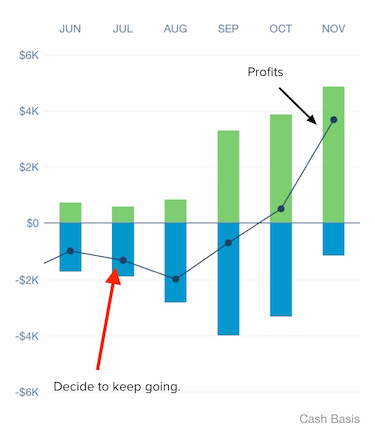From Failure to Freedom — How I Persevered Long Enough to Beat the Odds
"Success isn't final, failure isn't fatal, it is the courage to continue that counts." —Winston Churchill
Six months ago, I was down.
I gave everything I had to turn Willpowered into a sustainable business – and my rewards for the effort were:
A company doomed to failureThousands of dollars of debtAnd a spot in my parent's basement.Ouch.
Here's a graph showing my financial situation at the end of June:

I endured months of losses, had no idea how to turn things around, and finally decided it was time to seriously consider quitting.
But as I reflected on how far I'd come, and what I wanted to do with my life, I came up with an idea that would build off my work with Willpowered and help me achieve more than I originally thought possible.
So I let go of all distractions, free time, and fear of embarrassment and got back to work.
Here's a graph showing what happened over the next five months:

Here's the real surprise: that growth isn't from Reverberation — it's from an app I built in a beginner's software development course. I took the course to learn how to build an app to save me a few hours on menial tasks...
...I ended up building one that will save me decades of time over the course of my life.
Here's are the key decisions I made to go from failure to freedom.
#1. Why I decided to "GET BACK IN THE RING"At some point in your life, I'm sure you've been in a similar position to me.
It was time for the "next step" in your life, and you asked yourself,
"What do I do now?"
These decision set the course for our entire lives – yet, they are the hardest to answer.
No matter what path you choose, it's impossible to know whether or not it's "right" until you've experienced it for weeks, months, or even years. This uncertainty can leave you feeling completely overwhelmed, stressed, and afraid of making a mistake.
So instead of asking yourself, "what do I really want in life?"
You'll likely turn outward and ask, "what should a person like me do in a situation like this?"
To see this rule in action, think back to a social event where you didn't know many people.
Did your intuition motivate you to "be yourself," or to "blend in?"
This motivation is human. Getting "in with the tribe" means:
SafetyReproductionFoodSurvivalHowever, when you turn outward for the answer, you don't ask the hard questions about what you really want out of life — and you ignore the unique experiences and development that help you stand out from the crowd.
When I faced this decision, I reflected on my own experience, passion, and purpose in life to find the right answer.
This doesn't mean I ignored the advice of my inner-circle, I simply took each person's advice within the perspective of their unique experience, passion, and purpose in life.
When my friends, family, and the rest of the outside world looked at my progress over the last six years, they could only see "an egg." I hadn't accomplished much, I was clearly making less progress in life than others my age (I mean, I was living at my parent's place) .
But on the inside, I was learning and growing in ways they couldn't see. I learned a lot about the market, the tools available, and most importantly, how much I truly believed in my work, and what I was willing to sacrifice to keep it going.
I call this The Egg Fallacy — taken from Jim Collins' book Good to Great. We allow the outsider's perspective to influence our decisions much more than we should. Even those closest to you still don't have a clue about what is and isn't possible for you.
I was on the verge of "breaking through the shell," and if I allowed the outside world to influence my decision, I would have thrown away years of progress.
#2 HOW I TOOK ON EACH PROBLEMIf I dumped out a box of 1000 puzzle pieces, how would you solve it?
Look online for "7 ways to solve a puzzle in less than an hour !"Try to come up with the "perfect plan" that will connect all the pieces effortlessly?Dig in until it started getting frustrating, then move onto a newer more exciting puzzle?Or take one piece, look at the box, figure out where it fits, then take another piece?The right answer is clearly #4.
It's a no-brainer. No matter how big or complicated the puzzle, it can be solved by taking it one piece at a time — goals are no different.
No goal worth pursuing will happen effortlessly (ever buy a puzzle with only 10-pieces?).
Whatever your goal, you will face moments of stress, frustration, and boredom. There will be times when you're stuck, there will be times when you realize that you put a piece in the wrong place and you need to take a step back.
But as long as you keep at it, the final picture will begin to take shape.
At that point, it may start getting harder, but you will begin to enjoy the process for its own sake. Before you know it, you have a completed puzzle, a small win under your belt, and the confidence to take on a 2,000-piece puzzle next.
The real factor that led you to success wasn't any one puzzle you solved, or best practice you used. It was the combination of all of them! And the will to push through the feelings of boredom, and frustration until you realized, "I got this."
As I approached the next decision, I was well into building my puzzle.
#3 HOW I LEARNED TO "BUILD AN EMPLOYEE"Despite all my willpower, I learned quickly that I wouldn't have time to run Willpowered while getting Reverberation off the ground.
So I mapped out all my tasks with Willpowered and circled each one that didn't require me.
The list included:
MarketingSocial mediaAccountingSalesFact-checkingAnalytics......essentially everything except creating content — which is my real value to subscribers.
However, I couldn't afford to hire anyone. I only had 2 months of cash left, and would need to pay the employee a real wage — which I hadn't even taken in almost a year.
So I went back to the drawing board to re-think things.
By this point, I've learned from experience that if you believe in what you're doing, you will find a way to make it happen.
I couldn't hire an employee, but perhaps...I could build one...
I had zero programming experience when I began this project in June. However, running an online business allowed me to see the industry create simpler and cheaper tools to help beginners like me get started.
I hadn't started the "programming section" of the puzzle yet, but I had conquered other unknown sections, such as writing, before, so I knew I could learn it if I just kept at it.
However, the reason I picked it up so quickly is because I clearly saw how this section fit into the whole picture of what I was working toward.
#4 HOW I LEARNED SO QUICKLYOn a very basic level, content creators have 3 jobs:
Create contentMarket contentDo each better next timeAll of my worst periods were when these three factors were out of balance.
If I didn't write consistently, my content became stale.
If I didn't market effectively, I wouldn't drive traffic to the site
And if I didn't analyze what was working, I'd write things nobody wanted to read.
So my goal with the app was to handle steps 2 & 3.
Thus, the app's purpose was clear:
Publish content that I create on various platforms like Twitter, Facebook, Emails, etc.Analyze what articles work and where to publish.Report back to me with recommendations about what to create nextWith that vision in mind, the learning path I needed to follow became crystal clear.
Because I knew the whole picture I was working toward, I could clearly see my progress, and how each piece fit.
Learning without a vision is like putting together the puzzle without seeing the picture on the box. It's certainly possible, but it will bring unnecessary frustration, wasted time, and doubts about how much progress you're making.
Those factors may just be enough for you to give up on it...
#5 how i persevered through the painEntering September, I'd only dug myself deeper.
At that point, even some of my strongest believers started to worry about me — especially when I responded to their concerns by stating my intentions of moving to London.
They were flabbergasted — and certainly deserved to be.
I only sunk deeper - what right did I say I could make it to London?
It turns out, none. I won't be making it there by the hard deadlines that I set — but that deadline helped me discover what I was truly passionate about as I pushed myself further than I knew was possible.
I learned that my passion isn't fueled by positivity or optimism, it's fueled by the pain, anger, and sadness I feel every time I see people give up faith in themselves, faith in others, and especially faith in the principles they hold dear.
I won't claim to be self-less, but what kept me going through all the failures, all the self-doubt, and all the long nights of beating my head against the wall, was not fame, fortune, or the freedom to travel the world.
It was my belief in the greatness within every individual. That deep down, everyone has the desire to become great at something they care deeply about — it doesn't matter if it's in science, sports, family-life, whatever.
If that person realizes this purpose, and discovers how to fit it into the world, they will treat each day as an opportunity, not an obligation — and we all benefit from it.
All the doubts, embarrassments, and failures were painful. But I woke up every morning with the idea that today was an opportunity to use science and technology to help every individual achieve whatever greatness they seek.
More than any strategy, tip, or best-practice; it is my genuine belief in that purpose that kept me in the game long enough to free my mind from the worries of making rent, and free my time to do what I really love to do with Willpowered — write.
But this was j. As Churchill said in his famous quote:
"Success isn't final."
Time break out the 2,000-piece puzzle.....



